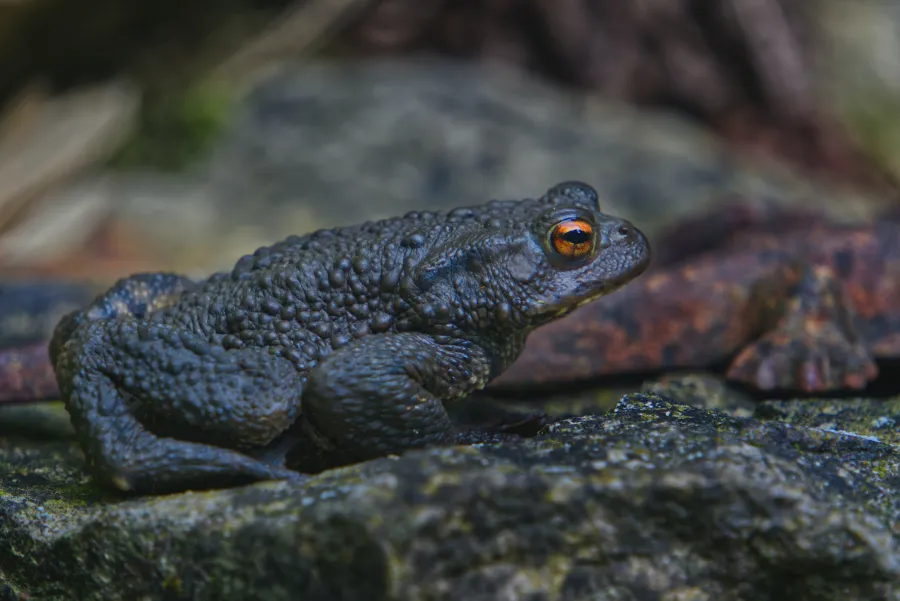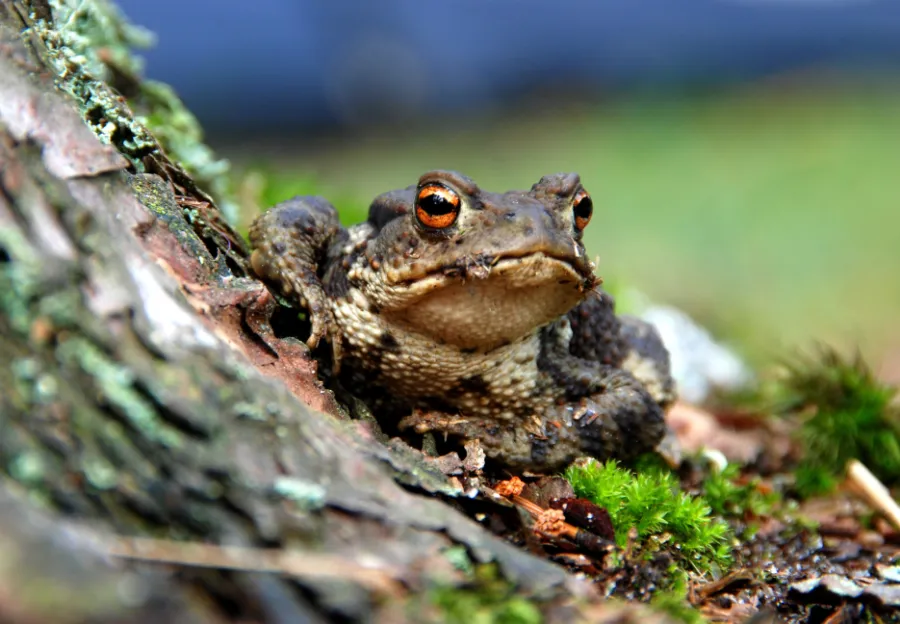
Frogs are found in a variety of habitats, from forests and wetlands to grasslands and urban areas. They are known for their adaptability and are able to survive in a range of temperatures and conditions. However, the winter months can be particularly challenging for frogs, as they must find ways to cope with cold temperatures, limited food sources, and increased predator activity.
To help frogs in winter, provide a warm, sheltered place and access to water. If you find a cold frog, place it in a warm, covered container and check on it periodically. If the frog is not improving or appears sick/injured, contact a veterinarian or wildlife rehabilitation center.
One of the main challenges that frogs face during the winter is finding a suitable place to shelter. Cold temperatures can be harmful to frogs, and they need to find a way to stay warm in order to survive. Frogs are ectothermic, meaning that they rely on external sources of heat to regulate their body temperature. In the winter, frogs may seek out warm, moist environments, such as under leaf litter or in hollow logs, in order to escape the cold. You might want to read my other article on encouraging frogs to come to your garden.
Provide winter shelter for the frogs
One strategy to assist frogs during the winter is to provide them with sufficient refuge. Depending on the resources and materials at your disposal, you may build a variety of frog houses.
Hollow logs
Hollow logs attract frogs because they provide a warm, damp habitat that is shielded from the outdoors. If you have a hollow log on your property, you may make it more appealing to frogs by filling it with leaf litter or other organic material. This will assist to retain heat and moisture, making the winter shelter more comfortable for frogs to utilize.
Leaf litter
Create a layer of leaf litter on your property to offer winter habitat for frogs. During the winter, frogs will frequently seek out leaf litter as a location to hide and remain warm. You may provide a suitable winter habitat for frogs by laying down a layer of leaf litter on your property. Keep the area clean of clutter and allow a clear passage for frogs to access the leaf litter.

Keep water sources open
Water is crucial for frogs, and it is critical that they have a consistent supply of hydration during the winter months. Frogs are vulnerable to dehydration during the winter because they are less active and may not be able to locate enough food to eat.
Keeping water sources available over the winter is one approach to assist frogs stay hydrated. This can be difficult since water sources freeze during the winter months. To protect water sources from freezing, use a heater or insulating material to keep them warm. You may also experiment with adding a little quantity of salt to the water to assist reduce the freezing point.
Protect the frogs from predators
Frogs are more vulnerable to predation during the winter because they are more active and conspicuous in search of food and refuge. Birds such as owls and herons, as well as mammals such as raccoons and foxes, are prominent frog predators.
Install fencing or obstacles around sites where frogs are known to reside to protect them from predators. You can also attempt deterring predators with loud noises or bright lights, as many animals are sensitive to these stimuli.
Provide food for the frogs
Food is a key aspect in frog survival throughout the winter. Frogs may have trouble getting food during the colder months because insects and other prey are less active or more difficult to find. By providing a food supply for frogs, you may assist to guarantee that they have enough energy to survive the winter.
You may feed frogs a variety of foods, depending on what is available and what the frogs appear to appreciate. Insects such as worms and beetles, as well as modest amounts of fruits and vegetables, are other alternatives. When feeding frogs, it is critical to prevent overfeeding, which can cause health concerns.
Other things to considerate
There are a few more things you can do to aid frogs over the winter, in addition to the procedures listed above. During the winter months, it is critical to avoid disrupting frog habitats, since this might interrupt their usual habits and increase their stress levels. If you must work in or near frog habitats, attempt to do it during the warmer months, when the frogs are more active.
You might also try monitoring frog numbers and detecting potential concerns. If you see that frog populations are falling or that individual frogs appear to be struggling, you may need to take extra precautions to safeguard them. This might involve giving more shelter or food, as well as addressing any special hazards or obstacles that the frogs face. You may assist to keep frog populations healthy and vigorous by remaining watchful and taking action when required.

What does a frog do in winter?
There are a few more things you can do to aid frogs over the winter, in addition to the procedures listed above. During the winter months, it is critical to avoid disrupting frog habitats, since this might interrupt their usual habits and increase their stress levels. If you must work in or near frog habitats, attempt to do it during the warmer months, when the frogs are more active.
You might also try monitoring frog numbers and detecting potential concerns. If you see that frog populations are falling or that individual frogs appear to be struggling, you may need to take extra precautions to safeguard them. This might involve giving more shelter or food, as well as addressing any special hazards or obstacles that the frogs face. You may assist to keep frog populations healthy and vigorous by remaining watchful and taking action when required.
What is the coldest temperature a frog can survive?
The capacity of a frog to live in frigid temperatures is determined by various factors, including the frog’s species, age and size, as well as humidity and wind conditions. Some frog species are more resistant to cold temperatures than others. Wood frogs (Lithobates sylvaticus, for example) can withstand freezing temperatures by creating vast quantities of glucose, which serves as a natural antifreeze in their tissues. They can live by freezing up to 65% of their body water. Other frog species, such as leopard frogs (Lithobates pipiens) and green frogs (Lithobates clamitans), may survive in colder temperatures, although their tolerance to freezing is lower than that of wood frogs. In general, the lowest temperature that a frog can withstand is determined by the unique conditions in which it is located.
Benefits of having frogs in your garden
Having frogs in your garden may give several benefits to both your plants and the whole ecology. Frogs may help decrease pest populations by consuming insects that might harm your plants, as well as improve soil health by contributing nutrients and stimulating microbial activity. Furthermore, frogs may pollinate flowers and disseminate plant seeds, promoting the development and reproduction of your plants. If you want to understand more about the precise methods in which frogs aid plants, you can read our article “How Frogs Help Plants.” By building a frog-friendly garden, you can not only help your plants’ health and survival, but you can also help the ecosystem’s general health and well-being.
How do you warm up a frog?
If you come across a chilly and lethargic frog, you can try to warm it up by doing the following:
- Take a small container or box and line it with a soft, dry material like a paper towel or tissue.
- Cover the frog with a cloth or paper towel and place it in the container.
- Place the container in a warm setting, such as beside a heater or in the sun.
- Check on the frog on a regular basis to ensure it is not overheated.
Because chilly frogs may be quite sensitive, it is critical to treat them softly and carefully. If the frog does not appear to be recovering after a few hours, or if it appears sick or damaged, you should seek help from a veterinarian or a wildlife rehabilitation facility.
It is also essential to know that it is illegal in many locations to keep wild frogs as pets, so unless you have permission from the relevant authorities, you should always consider releasing the frog back into the wild after it has warmed up.
In conclusion
In conclusion, there are numerous strategies to assist frogs throughout the winter. Winter shelter, open water sources, predator protection, and food provision are all vital efforts you can take to help these important creatures. By following these steps, you may help frogs survive and prosper in their native environments throughout the winter months.
